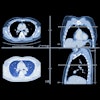More than half of patients who undergo CT scans for suspected abdominal conditions receive an additional series of tests that are unrelated to and unnecessary for diagnostic purposes. If extrapolated, this level of overexposure could result in up to 20,000 radiation-induced cancers per year in the U.S.
That's according to a study presented at this month's RSNA meeting by researchers from the University of Wisconsin, Madison. They found that abdominal CT can expose a patient to as much as 70 mSv of radiation in a scan than should register 42 mSv, representing 28 mSv of extra radiation exposure, said Dr. Kristie Guite, a radiology resident at the university.
"It is the responsibility of all physicians who work with ionizing radiation to ensure that the dosage is as low as reasonably achievable [the ALARA standard] without compromising the patient's well-being," Guite said at the Chicago meeting.
"Our study found that this principle is not being followed in many studies," she said in a press briefing. According to Guite, researchers have suggested that doses in excess of 100 mSv may cause symptoms of radiation illness and may increase risk of radiation-induced cancer.
In their study, Guite and colleagues reviewed data on 500 patients, who received a total 978 series of scans at outside institutions, with CT scans then forwarded to the University of Wisconsin radiologists for review. The research team evaluated the CT studies for how they compared to the American College of Radiology's (ACR) Appropriateness Criteria.
Of the 500 people included in the study, 261 (52.2%) received scans that weren't clinically indicated. In all, 192 patients received single-phase CT studies, while the remaining 308 patients received multiple scans -- up to five studies. Guite said 263 of those studies were not clinically indicated. "That means 62% of all the patients received multiple phases, and 85% of those multiple phases were not indicated," she said.
The researchers found that the mean radiation dose per patient was 34 mSv ± 24.1 mSv. Unindicated imaging series had a mean dose of 16.3 ± 9.4 mSv, which resulted in a mean excess dose of 11.3 mSv per patient for the entire study population. Guite said about 20% of records she examined indicated that the patients received more than 50 mSv of radiation, and seven of the 500 patients received greater than 100 mSv in a single examination.
"We suspect that at many institutions there is a lack of focus on selecting CT protocols tailored specifically to answer the clinical question," said co-author Dr. J. Louis Hinshaw, assistant professor of radiology at the University of Wisconsin. He also suggested that having the tools and the ability to use them may also set in motion additional tests.
"The less you need to do is what should be your goal," said press conference moderator Dr. Robert Zimmerman, professor of radiology and director of diagnostic imaging at New York-Presbyterian Hospital/Weill Cornell Medical College in New York City. "But there are protocols for CT that have been previously set, and someone just pushes a button. A lot of this may be risk aversion -- defensive medicine practices."
The researchers concluded by stating that the practice of adding noncontrast and delayed-series appears to be common in routine clinical practice and "represents a public health danger with no associated clinical benefit."
By Ed Susman
AuntMinnie.com contributing writer
December 15, 2009
Related Reading
FDA finds new cases of CT radiation overexposure, December 7, 2009
NEJM study: Imaging procedures, radiation growing, August 26, 2009
Radiation dose and cancer risk in pediatric CTA exams, August 21, 2009
Repeated calcium scans increase cancer risk, study finds, July 13, 2009
Higher cancer risk seen in frequently scanned patients, March 31, 2009
Copyright © 2009 AuntMinnie.com




















